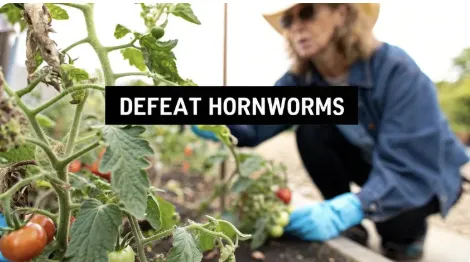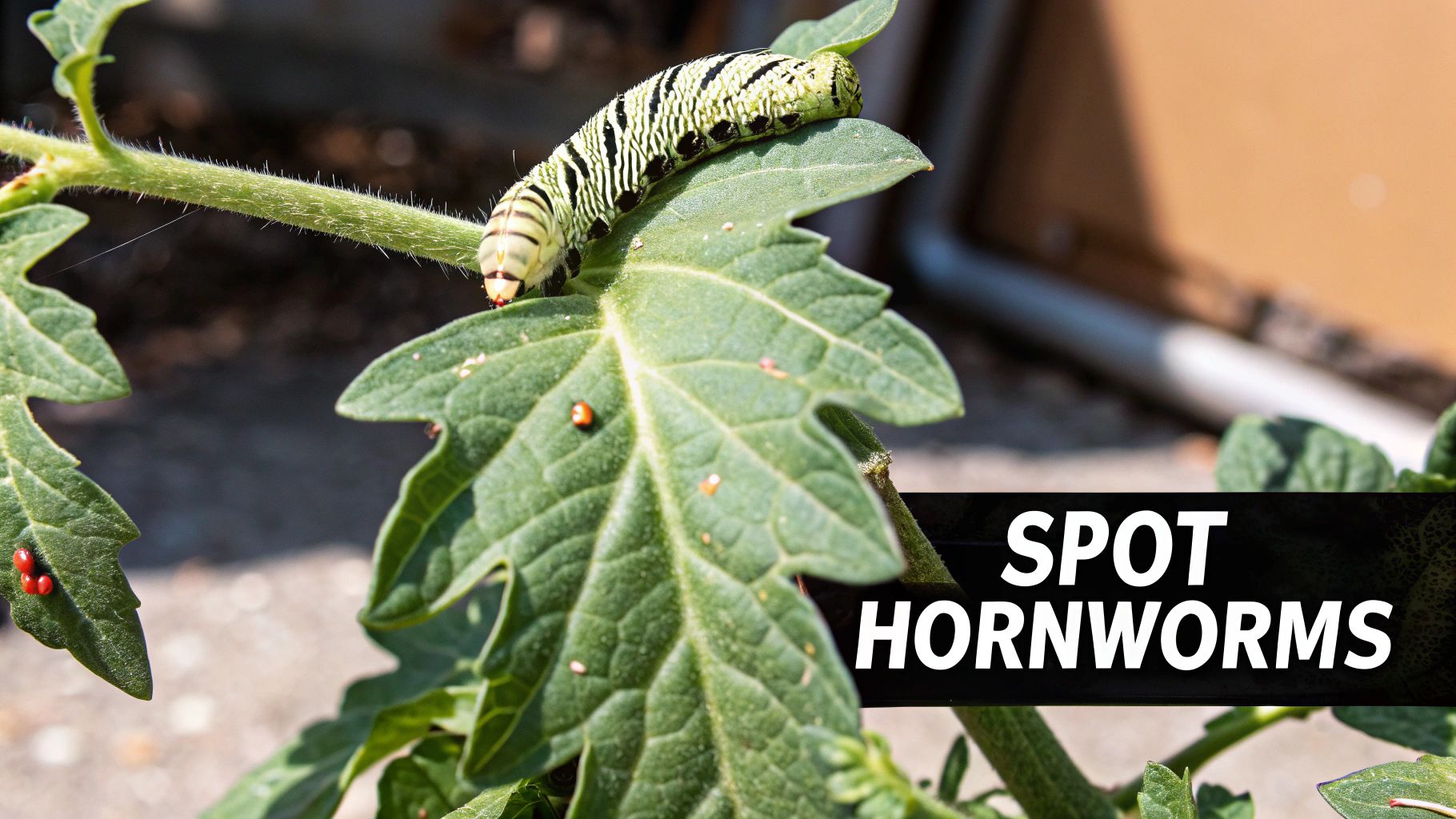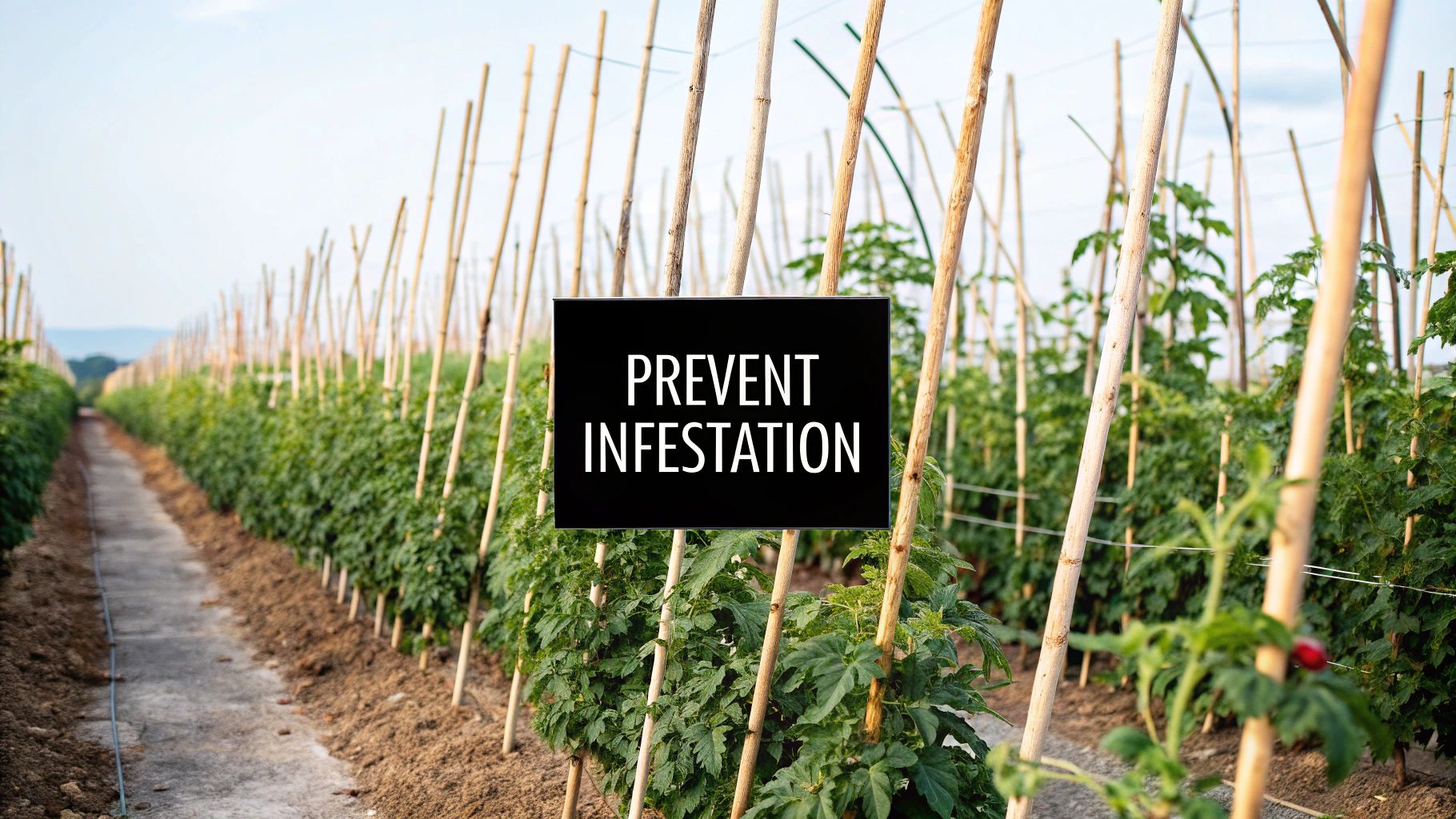
How to Get Rid of Hornworms for Good
How to Get Rid of Hornworms for Good
The fastest way to get rid of hornworms is to pull them off your plants by hand and drop them into a bucket of soapy water. It's simple, direct, and stops the damage instantly. If you're facing a bigger invasion, an organic spray with Bacillus thuringiensis (Bt) is your best friend—it targets caterpillars specifically without bothering other wildlife.
Your Emergency Action Plan for Hornworms

It’s a gut-punch moment for any gardener: you walk out to your prized tomato plants and find them stripped nearly bare overnight. If you suspect hornworms, you need to act fast. This is your go-to plan for identifying the culprits and taking back your garden right now.
These incredibly hungry caterpillars are the larval stage of the sphinx moth (sometimes called a hawk moth). Both tobacco and tomato hornworms are major pests across North America, capable of defoliating entire plants if you let them. They stick to a specific diet: plants in the nightshade family, like your tomatoes, peppers, eggplants, and potatoes. You can read more about the broader impact of hornworms at farms.com.
Confirming a Hornworm Problem
Before you declare war, you need to be sure you're actually dealing with hornworms. They have incredible camouflage and can be surprisingly hard to see, even though they get huge. Most of the time, you'll see the damage they cause long before you ever spot the caterpillar itself.
The biggest clue is severe defoliation—entire leaves and even small stems just gone, almost like they vanished. Another dead giveaway is their droppings, called frass. Look for dark green or black barrel-shaped pellets on the leaves or the ground beneath the plant. They’re quite large, and if you see them, a hornworm is feeding somewhere close by.
Gardener's Tip: The best time to go hornworm hunting is early in the morning or just as the sun sets. They’re more active when it's cool, and you can often follow their munching sounds. A UV flashlight is another great trick; it makes them glow in the dark, revealing their hiding spots instantly.
Quick Hornworm Identification Guide
Use this simple checklist to confirm if you have a hornworm problem. If you spot two or more of these signs, it's time to get to work.

Once you’ve confirmed the signs, you can move on to the best methods for getting them off your plants for good.
Mastering Manual Hornworm Removal
Sometimes, the best tool in your garden shed is your own two hands. For most of us with backyard gardens, manually removing hornworms is the single best way to shut down an infestation before it gets out of control. It’s immediate, it’s effective, and it’s completely organic.
The secret is knowing when and where to look. These caterpillars are masters of disguise, blending in perfectly with the green foliage of a tomato plant. Your best bet is to go on the hunt during their golden hours: early in the morning and again at dusk, when they're most active. Check the undersides of the leaves, especially anywhere you see fresh damage.
The Best Techniques for Spotting Hornworms
Here’s a simple trick that feels like a bit of garden magic: use a blacklight or UV flashlight at night. When you shine it on your plants, any hornworms will glow a bright, ghostly green. Suddenly, they're impossible to miss. This little hack turns a frustrating search into a quick and satisfying mission.
Once you’ve got one in your sights, the next step is easy. Just gently pluck it from the plant. They’re harmless and won't bite or sting.
The most straightforward approach is often the best. Hand-picking hornworms not only removes the immediate threat but also gives you a clear sense of the infestation's scale, helping you decide if further action is needed.
What to Do After You Find Them
So, what do you do with a handful of hornworms? You have a few options, depending on your comfort level.
Soapy Water: Dropping them into a bucket of soapy water is a quick and effective method.
Chicken Feed: If you have backyard chickens, hornworms are a protein-rich treat they will go absolutely wild for.
Relocation: You can move them far away from your garden, though they may not survive without their specific host plants.
Don't underestimate this hands-on approach. Research shows that hand-picking and other old-school practices are still highly effective. In fact, one study highlighted success rates of up to 90% larval mortality by combining these methods with proper soil tillage. You can discover more about these crop impact findings.
While effective, it's just one piece of the puzzle. For a broader view on keeping your plants healthy, check out our guide on common tomato problems and solutions.
Bring in the Good Guys: Using Natural Predators in Your Garden
Why go to war with hornworms by yourself when nature has already recruited an army for you? Creating a garden that welcomes beneficial insects is one of the smartest, most sustainable ways to handle pests. You’re not just solving a problem; you’re building a balanced, resilient ecosystem that takes care of itself.
The hornworm’s number one enemy is the braconid wasp. If you ever spot a hornworm with what looks like tiny white rice grains stuck to its back, step away! Those are the wasp’s cocoons. The larvae are feeding on the caterpillar from the inside out, and when they emerge, a new generation of tiny pest assassins will be patrolling your garden.
Ladybugs and lacewings are also fantastic allies. They’re voracious predators that devour hornworm eggs and tiny larvae, stopping a potential infestation before it ever gets started.
How to Create a Welcoming Habitat
Attracting these garden guardians is simpler than you might think. It really just comes down to smart companion planting. By mixing certain flowers and herbs in with your vegetables, you create the perfect environment for beneficial insects to stick around.
Plant these to draw in your allies:
Dill and Fennel: These herbs are practically magnets for ladybugs, lacewings, and parasitic wasps.
Marigolds: While famous for warding off other pests, their flowers also provide essential nectar for the good guys.
Sweet Alyssum: This low-growing flower acts as a "living mulch," offering both shelter and food for hoverflies and minute pirate bugs.
A diverse garden provides the food and shelter these helpful predators need to thrive. For a deeper look at this strategy, check out our guide on powerful methods for natural pest control in your garden.
Give Nature a Nudge with Organic Biological Treatments
Sometimes, you need to give nature a helping hand. Thankfully, there are organic treatments that are incredibly effective against hornworms without harming the rest of your garden's inhabitants. The best and most trusted is a microbe called Bacillus thuringiensis (Bt).
Bt is a naturally occurring bacterium found in soil that specifically targets caterpillars and moth larvae. When a hornworm eats leaves that have been sprayed with Bt, the bacteria release a protein that destroys its digestive system. It stops feeding within hours and dies off in a day or two.

The real beauty of organic solutions like this is their precision—they target only the pest you want to eliminate, leaving the rest of the ecosystem intact.
One of the biggest advantages of using Bt is its safety profile. It’s completely harmless to humans, pets, birds, fish, and crucial pollinators like bees. This makes it an ideal tool for any gardener focused on maintaining a healthy, balanced, and safe environment.
Comparing Hornworm Control Methods
Choosing between organic and conventional treatments can feel tricky. Organic methods work with your garden's ecosystem, while conventional options offer a faster, more direct approach. This table breaks down the pros and cons to help you decide what’s right for your garden.

Ultimately, the best approach often involves a mix of strategies. By starting with organic, ecosystem-friendly methods, you can often solve the problem before ever needing to reach for something stronger.
When hand-picking and natural predators just aren't cutting it—and you're watching a hornworm invasion chew through your future harvest—turning to a chemical spray can feel like the only option left.
It's a step no gardener takes lightly. Insecticides can cause serious collateral damage, harming the very ecosystem you’ve worked so hard to build in your garden.
If you find yourself at this point, the goal is simple: get rid of the hornworms while doing the least possible harm to the good guys—the bees, ladybugs, and parasitic wasps that keep your garden in balance. This isn't about blanketing your garden; it's about a targeted strike.
How to Choose and Apply Safely
Before you even think about buying a product, read the label. Seriously. The label is your most important tool. It tells you exactly what pests the product targets, how to apply it safely, and what precautions you need to take to protect yourself and the environment around you.
Look for insecticides with active ingredients like spinosad or pyrethrin.
Spinosad is a natural substance made by a soil bacterium. It’s highly effective on caterpillars but is less harmful to many beneficial insects when you apply it correctly.
Pyrethrin comes from chrysanthemum flowers. It breaks down quickly in sunlight, which helps reduce its long-term impact on your garden.
Safety First: Timing is Everything Always, always apply insecticides in the late evening or very early in the morning. This is when pollinators like bees are least active, which drastically cuts down the risk of accidentally harming them. Protecting these vital members of your garden's ecosystem is non-negotiable.
When you're ready to spray, focus only on the plants that are actually under attack. Spot-treat the specific areas where you see hornworms and their damage. Don't spray everything in sight. This targeted approach contains the chemical's impact, protects the rest of your garden, and ensures you're only using as much as is absolutely necessary.
Long-Term Prevention for a Hornworm-Free Garden

Winning a battle against hornworms is satisfying, but winning the war means making sure they don't get a foothold in the first place. This is where proactive, long-term prevention comes in. Think of it as building a stronger, smarter garden—one that’s a whole lot less inviting to the sphinx moths looking for a place to lay their eggs.
One of the most powerful moves you can make happens long after your tomatoes are gone. Come fall, a thorough tilling of your garden soil can make a massive difference. This simple act churns up and exposes the hornworm pupae trying to overwinter just a few inches below the surface. Exposed to the cold and predators, very few will survive to emerge as moths next spring.
Smart Garden Habits for a Resilient Patch
Beyond tilling, a few other gardening habits can dramatically cut down your chances of a hornworm invasion. Smart garden planning is your best defense against a whole host of pests, and the voracious hornworm is no exception.
Practice Crop Rotation: Whatever you do, avoid planting nightshades (tomatoes, peppers, potatoes) in the same spot year after year. Moving them to a different bed forces any surviving pupae to emerge far from their food source, which is often enough to break the pest cycle for good.
Use Physical Barriers: Lightweight row covers are a fantastic tool, especially when your plants are young and vulnerable. Draped over your crops, they create a simple physical barrier that stops sphinx moths from ever landing and laying their eggs.
Encourage Biodiversity: A garden humming with a variety of plants is a healthy garden. This includes companion planting, a topic we cover in our guide to vegetable companion planting.
These pests are persistent travelers. Originally from Central America, hornworms have spread throughout the Americas, earning a name that reflects their destructive nature. Manduca, the genus name for hornworms, is Latin for “glutton”—a fitting title for a creature that can defoliate a tomato plant with frightening speed.
By working these preventative strategies into your yearly gardening rhythm, you create a robust defense that helps you finally get rid of hornworms for good.
Common Questions About Hornworms Answered
Even with the best plan, you're bound to run into a few head-scratchers when dealing with pests. I get these questions all the time, so let's tackle the most common ones about hornworms.
What Are the White Things on a Hornworm?
If you spot a hornworm covered in what looks like tiny white grains of rice, you’ve just found one of your best garden allies at work. Those aren't eggs—they're the cocoons of a parasitic braconid wasp.
The wasp larvae are actually feeding on the hornworm from the inside out. It’s brutal, but it’s nature’s pest control.
Whatever you do, let this hornworm live. By leaving it be, you’re basically letting a whole new generation of beneficial wasps hatch and patrol your garden for you. It's a helping hand you don't have to pay for.
Do Hornworms Only Eat Tomato Plants?
Tomatoes get all the attention, but hornworms are specialists that feast on the entire nightshade (Solanaceae) family.
This means you should also be checking your pepper, eggplant, and potato plants. They are all prime targets for these hungry caterpillars. Knowing this helps you expand your search beyond just the tomato patch. Vigilance across all your nightshade plants is the key to catching them early.
On a reassuring note, hornworms are completely harmless to people and pets. They don't bite or sting, and they aren’t poisonous. Despite their intimidating size and that little "horn" on their tail, you can safely pick them off your plants without any risk at all.
At The Grounded Homestead, we believe that knowledge is the best tool for growing your own food. For more tips and insights delivered to your inbox, check out our weekly newsletter at https://thegroundedhomestead.com.


Facebook
Instagram
X
Youtube